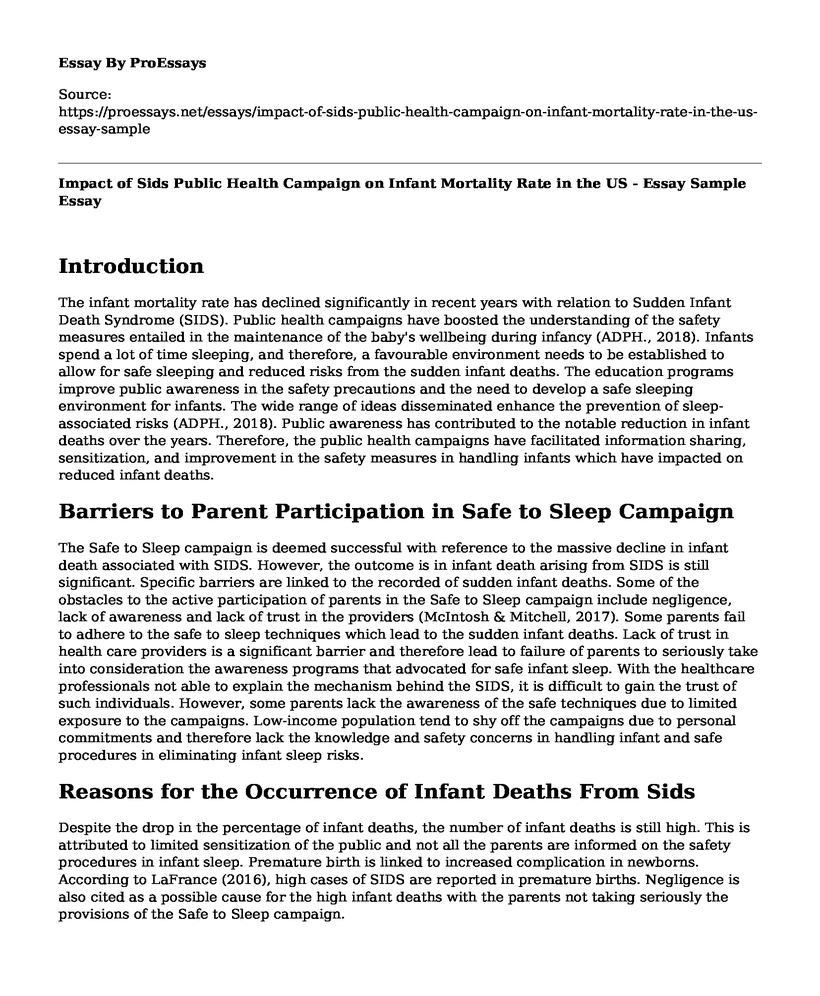Introduction
The infant mortality rate has declined significantly in recent years with relation to Sudden Infant Death Syndrome (SIDS). Public health campaigns have boosted the understanding of the safety measures entailed in the maintenance of the baby's wellbeing during infancy (ADPH., 2018). Infants spend a lot of time sleeping, and therefore, a favourable environment needs to be established to allow for safe sleeping and reduced risks from the sudden infant deaths. The education programs improve public awareness in the safety precautions and the need to develop a safe sleeping environment for infants. The wide range of ideas disseminated enhance the prevention of sleep-associated risks (ADPH., 2018). Public awareness has contributed to the notable reduction in infant deaths over the years. Therefore, the public health campaigns have facilitated information sharing, sensitization, and improvement in the safety measures in handling infants which have impacted on reduced infant deaths.
Barriers to Parent Participation in Safe to Sleep Campaign
The Safe to Sleep campaign is deemed successful with reference to the massive decline in infant death associated with SIDS. However, the outcome is in infant death arising from SIDS is still significant. Specific barriers are linked to the recorded of sudden infant deaths. Some of the obstacles to the active participation of parents in the Safe to Sleep campaign include negligence, lack of awareness and lack of trust in the providers (McIntosh & Mitchell, 2017). Some parents fail to adhere to the safe to sleep techniques which lead to the sudden infant deaths. Lack of trust in health care providers is a significant barrier and therefore lead to failure of parents to seriously take into consideration the awareness programs that advocated for safe infant sleep. With the healthcare professionals not able to explain the mechanism behind the SIDS, it is difficult to gain the trust of such individuals. However, some parents lack the awareness of the safe techniques due to limited exposure to the campaigns. Low-income population tend to shy off the campaigns due to personal commitments and therefore lack the knowledge and safety concerns in handling infant and safe procedures in eliminating infant sleep risks.
Reasons for the Occurrence of Infant Deaths From Sids
Despite the drop in the percentage of infant deaths, the number of infant deaths is still high. This is attributed to limited sensitization of the public and not all the parents are informed on the safety procedures in infant sleep. Premature birth is linked to increased complication in newborns. According to LaFrance (2016), high cases of SIDS are reported in premature births. Negligence is also cited as a possible cause for the high infant deaths with the parents not taking seriously the provisions of the Safe to Sleep campaign.
References
ADPH. (2018). Safe Sleep Outreach | Alabama Department of Public Health (ADPH). Retrieved from https://www.alabamapublichealth.gov/perinatal/safe-sleep-outreach.html
LaFrance, A. (2016). How Many Babies Really Die of SIDS?. Retrieved from https://www.theatlantic.com/health/archive/2016/06/understanding-sids/485147/McIntosh, C. G., & Mitchell, E. A. (2017). The evolving understanding of sudden unexpected infant death. Pediatric annals, 46(8), e278-e283.
Cite this page
Impact of Sids Public Health Campaign on Infant Mortality Rate in the US - Essay Sample. (2022, Dec 01). Retrieved from https://proessays.net/essays/impact-of-sids-public-health-campaign-on-infant-mortality-rate-in-the-us-essay-sample
If you are the original author of this essay and no longer wish to have it published on the ProEssays website, please click below to request its removal:
- Sociology Essay Sample on Rise in Geriatric and Palliative Care as America Ages
- South East Medical Center Case Study
- Is Weight Loss Maintenance Possible? - Essay Sample
- Euthanasia Responses Example
- Geriatric Nutrition for Heart Disease - Essay Sample
- Essay Example on the Battle Against AIDS: David France's 2012 Documentary
- COVID-19 and Prison System - Report Example







